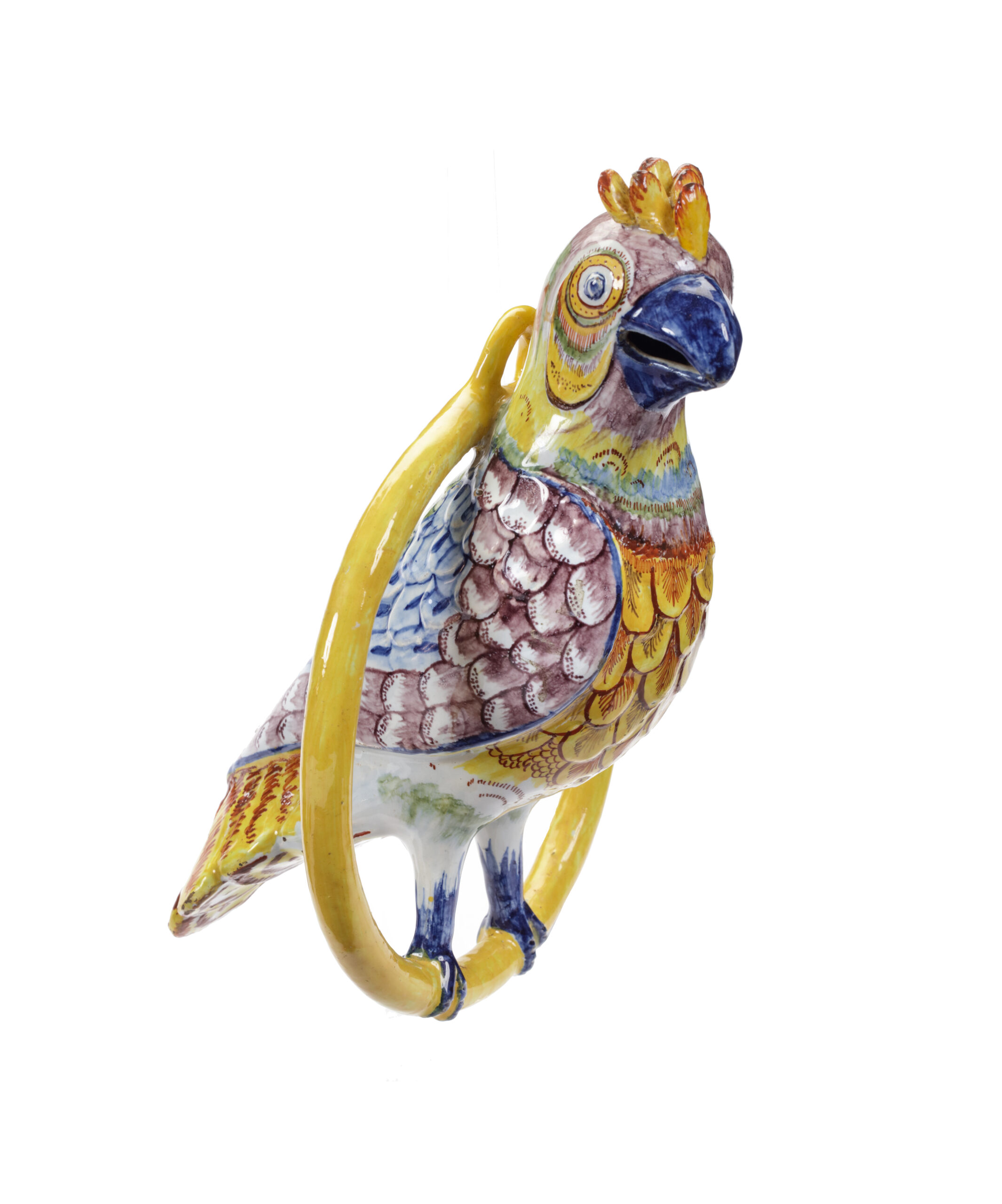[popup_trigger id=”13756″ tag=”span”]![]() [/popup_trigger]
[/popup_trigger]
Images on this website are licensed under a
Creative Commons Attribution-NoDerivs 3.0 Unported License.
OBJECT
•D2223. Polychrome Figure of a Parrot in a Ring
Delft, circa 1780
With boldly modeled plumage on the yellow breast and manganese and blue plumage on the wings, green back and iron-red dashed yellow tail, the yellow crest feathers also dashed in iron-red, the eyes, beak and feet colored in blue, and modeled perched on a yellow ring with a suspension loop affixed at the top.
DIMENSIONS
Height: 26.6 cm. (10.5 in.)
PROVENANCE
Collection S. Alberge, La Haye, no. 50 and bearing the original collector’s label; Probably auctioned on November 11th, 1954 at Frederik Muller & Cie, Amsterdam, lot 262
NOTE
The exoticism of parrots have remained since the eighteenth century when the colorful birds were popularly used as models in both porcelain and pottery. Like many Delftware objects, the ceramic parrots were first inspired by Chinese porcelain wares from the Kangxi period (1662-1722). The porcelain parrots found widespread appeal in both China and Europe for their colorful and exotic appearance, the earliest pieces often in the famille verte palette. Once the figures reached the Netherlands, they found a ready group of buyers. The bird was introduced into the Delft pottery repertoire, joining the more common animal imagery of dogs, cows and horses.
The varying colors and shapes of parrots provided the Delft painters with many options for ornamental decoration. The basic form was a naturalistic rendering of a parrot, but some bird figures were modeled after the porcelain blanc de Chine hawks, illustrated in exh. cat. Blanc de Chine, 1985, p. 15, no. 19. With their strong legs, high chest and claws, they appear sturdy and serious. However, the plumage is painted with bright colors and patterns not seen in nature, making these forms beautiful ornaments for the interior. The Delftware birds were produced in several models, and are often seated on an oval base or a naturalistic pierced rock. Other examples are seated on a branch or, as the present example, in a ring that could be suspended from a higher attachment point.
SIMILAR EXAMPLES
Dutch Delft parrots perched on a ring seem to have been among the later models of this intriguing and popular bird, and their depiction in this pose also appears as the decoration on Delftware plates. According to C.J.A. Jörg and F.T. Scholten, “De Collectie Delfts aardewerk in het Groninger Museum,” Groningen 1990, in M.M.V.V.C. (1990), 140, p. 44, these models might have been intended to serve as affordable substitutes for the rare and expensive live examples. A very similar parrot is illustrated by Boyazoglu 1983, p. 74, no. 151; and Boyazoglu, de Neuville 1980, p. 257, pl. 84. Others of this general size are illustrated by Lavino, pp. 46 (bottom, center), 129 (top, left) and 147 (top, left); by Mees 1997, p. 192 (center); in Nederlandse Vereniging van Vrienden van de Ceramiek, Mededelingenblad 140, p. 44, no. 83; and in Aronson 2003, p. 58, no. 56. A larger example is illustrated by Neurdenburg, Rackham 1923, pl. L, g. 81; several smaller examples are illustrated in Schaap 2003, pp. 60-61; Aronson 2000/2001, no. 37, Aronson 2007, pp. 56-57, no. 42, and Aronson 2019, pp. 134-135, no. 68.









